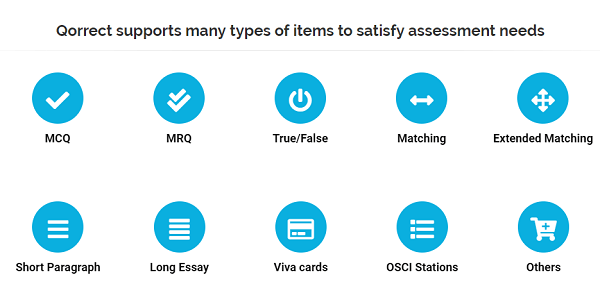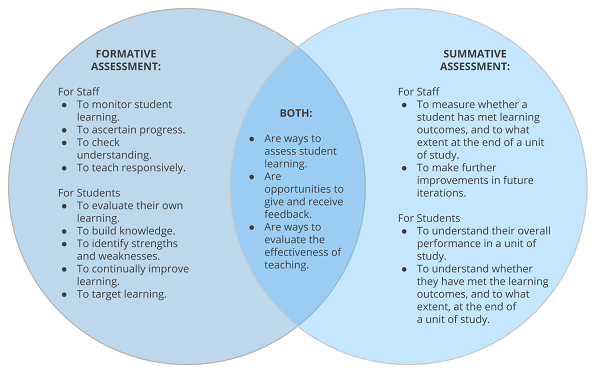Summative assessment is not fun! It is something only used to assess students’ grades and that’s it. Or at least this is what some may imagine.
This conviction is certainly a little widespread, although it barely scratches the surface of the importance of this assessment and how engaging and equally constructive it can be with the right tech.
If we truly need a better understanding and to come up with a more accurate image of this type of assessment, we have to delve deeper into it.
Let’s thoroughly look at the purposes of summative assessment, how to professionally and analytically evaluate it, its importance in comparison to formative assessment, and the best state-of-the art online assessment systems that can generate it.
Table of Contents
1. Purpose of Summative Assessment
The purpose of summative assessment is to answer the following questions:
- Did all students learn the material?
- Are all students meeting the standards?
- Are we successful with all students?
There have been some calls for stopping summative assessment in college. The supporters of this claim that summative questions, however long the exam is, will never cover the whole curriculum. They do not offer a chance for professors to look closely at each of their students.
Some students naturally get anxious during the exam but that does not stop them from acing them. They can manage their anxiety and are able to separate this feeling from what is happening during the examination.

Others feel overwhelmed no matter what they do and, consequently, errors happen in the exam. Have you ever been shocked after an exam that you didn’t get the right answer, or simply couldn’t remember it? Yes, that’s it!
Although this is true for some, the great importance of this kind of assessment has been proven as true by practice as well as in theory.
If you’d like to know how to create a summative assessment via online assessment software, check our Youtube channel.
Summative and Formative assessment examples
Formative and summative evaluations are considered essential processes for assessing learner development and the effectiveness of educational plans in achieving their intended goals.
The difference between formative and summative evaluation, therefore, aims at a deep understanding of both, to enable evaluators to choose the most efficient and appropriate way to achieve the desired purpose of the evaluation.
To illustrate summative versus formative assessment in practice, some examples of formative and summative evaluation are given here.
Examples of formative evaluation
Examples of the assessment are ways that clarify summative versus formative.
Here are different examples of formative assessment:
- Discussions.
- Worksheets.
- Quizzes.
- Case studies.
- Peer assessment.
- Simulations.
Examples of summative assessment
There are different summative assessments examples, such as:
- Written exams.
- Assignments.
- Presentations.
- Graduation projects.
- Essays.
- Learner showcase.
- Dissertation.
How to Evaluate Your Summative Assessment via Online Assessment Software?
A summative assessment drives students to work harder. It gives them a purpose to work for. It allows them to see their months and months of study and hard work materializing right in front of them.
Despite it being of a more black and white nature, due to its nature, summative assessment is needed now more than ever in universities and colleges.
With the right technology, it can be more colorful though. With good online assessment software, a summative assessment evaluated, analyzed, measured against other tests to see its effectiveness.
The online assessment system, Qorrect, allows you to easily see how each subject, lesson, section, and learning objective is covered in the test you are creating.
It gives the opportunity to ask more than one type of question, not limiting you to only MCQs or short answers, an advantage that differentiates Qorrect from other computer-based testing (CBT) systems.
2. What Are Some Questions Used Creating Summative Assessments?
Although some professors mostly still use standardized testing in summative assessment, summative questions don’t always have to be standardized exams.
In her article “How Many Questions Should You Have on a Summative Assessment?” Chris Jakicic, an author, a consultant, and a previous principal of Woodlawn Middle School in Illinois, recommends considering other methods to assess students and their learning “beyond the typical multiple choice and constructed response questions.”

Types of questions online assessment software Qorrect offers when creating a summative assessment
Using Qorrect online assessment software, your summative exam’s question will vary between MCQs, short answer, true/false, matching, essays, viva cards, OSCI stations, and even research papers.
If you are starting your question bank soon, you might find the “A Short Guide
to Writing Effective Test Questions,” developed by Kansas Curriculum Center, very useful.
The Quantity of Test Questions Affect Its Quality: A Myth or a Fact?
As teachers, this is a question we sometimes find ourselves in front of, how many questions should be enough? I mean, how many questions does a question bank have to have in order to be of good quality? Does the quantity of question really affect the test quality?
Interviewing Qorrect’s online assessment software team, we now have the answer. The more questions you, as a teacher, add to your school or college question bank, the higher the quality of your test.
Think about it this way. These are the last few months of your job at a company. You were requested to hire someone else to fill in your shoes once you officially leave.
Naturally, you will be giving this person some training in his first few months of the job. Now, your trainee is still processing everything around him. All the work he needs to do. He is, like a computer-based testing (CBT) system, a blank sheet you need to fill in with details, information, etc.
It takes time for you to fill him on everything. But once he gets the hang of it, he starts to really excel at the job. He even gets something new to the table, his own new unique view.
This is exactly how it is with an online assessment solution! The more questions you enter, the more tests you create using the solution, and the better their quality, the better the quality of the summative assessment your students will get.
Your online assessment system will have enough data for analysis, enough results to work on from previous exam questions, and more quality to boost the examination.
3. What Is the Difference between Formative and Summative Assessment?
We often receive many questions regarding the difference between formative and assessment questions and whether the latter is more important.
There is a lot of confusion on this issue. In fact, a great number of studies have been recently published comparing both types of assessment and recommending the best option for school teachers and college professors (read our article “Essential Teaching Skills Secrets for a Better Lecture“) to go for in the classroom.
However, the truth is that using both forms of assessment in the classroom is the best recommendation most education experts advise.

Credit: The University of Sheffield
In the above image, the University of Sheffield offers an overview of the main differences between the purposes of both formative and summative assessment, for students as well as for teachers.
And formative assessment is defined as a type of evaluation that can be both formal and informal used to make students practice what they have learned within the classroom and ensure the direction the teacher is taking towards fulfilling the learning objectives.
Moreover, it helps you guide the way your teaching goes, depending on how each student responds to every formative assessment.
The Main Features of Formative Assessment
- It does not usually affect the final grade
- It doesn’t have to have a pass/fail factor
- It helps familiarize students with the material and reduce their anxieties
- It essentially provides quality feedback
- They can be quizzes, learning games, or just classroom discussions
On the other hand, the main summative assessment is generally held at the end of month, term, or year as explained in the below video:
Summative Evaluation Features
- It’s formal
- It’s time-specific
- They can be projects, essays, standardized tests, presentations, reports, or research papers
- They usually don’t have feedback, unless students specifically ask for it
In her research, Helen Timperley, a Professor of Education at the University of Auckland in New Zealand, explains in detail how necessary formative assessment is to the development of the educational process:
“It is difficult to change from traditional ideas where assessment data was considered to be reflective of students’ abilities about which little can be done, to one where assessment data is considered to be information to guide reflection about the effectiveness of teaching and what needs to happen next.”
To make this change happen though, we need the following:
- To change how teachers and school administration use assessment data
- To develop a ‘deeper pedagogical content knowledge’ to deal positively with this data
- Changing teaching practices to more modern ones
- Constantly checking the impact of these changes on students
Both assessments are an integral part of the student progress and the education process’ success. One can’t go without the other while using effective classroom teaching strategies. While formative assessments capture students’ progress after each lesson, summative assessments reveal their long-term one.
Get a closer experience on formative and summative evaluation via our Youtube channel.
4. Why Is Summative Assessment Important in University?
In his book “Deeper Learning through Technology: Using the Cloud to Individualize Instruction,” Ken Halla shares with us his thoughts on summative evaluation in education and how to best benefit from it!
He advises us to use this type of assessment to determine whether students have fully grasped the material they studied or not.
But what happens if a student fails their formative assessment but succeeds in the summative test? What should teachers do in this case?
If the work here is superior and adequate mastery is demonstrated, the question a teacher then must consider is whether earlier failures on the unit’s materials or formative exams should be discounted. — Ken Halla
Halla urges teachers to assess whether to start considering this. He relates examination to the language of this age: video games and how much players see the words ‘game over’ before they finally win. This is how we should view formative assessment.
Testing, Testing: Formative & Summative Assessment in the University
Online games are one of the first things children these days learn in their life. Although they do have many disadvantages, they teach them trial and error.
They make them unconsciously learn what Thomas Edison learned after years of trying and failing to come up with the technology that helped bring light bulbs into the masses.

Credits: Britannica.com
When a reporter asked Edison “How did it feel to fail 1,000 times?” he replied “I didn’t fail 1,000 times. The light bulb was an invention with 1,000 steps.”
In her article on Forbes, Sally Percy explains this by saying that it’s practically good to be bad sometimes:
The reality is that rather than valuing failure, society teaches us to despise it. That’s why we do our best to avoid mistakes at all costs. Rather than a litany of “learning experiences”, what we would much prefer – or what we think we would prefer – is plenty of success, ideally achieved overnight. We would like to have perfect careers, homes, relationships and children without having to go to the trouble of getting things wrong now and again.
Computerized exams systems should be secure, easy-to-use, and simple. Find all 3 features by requesting a FREE demo now.
Getting It Wrong Is Doing It Right
Since getting it wrong is the best way to get it right and flourish, professors are encouraged to create many formative assessments within the classroom.

Having quizzes and assessments without pass or fail grades relieve students’ state of mind and encourage them to fully participate and engage with the teacher with no fear.
Still, some students will not get it right from the first quiz. And that’s okay. It’s what formative assessments are there for! It’s a step by step learning path teachers take their students to in order to finally reach the summative assessment.
For this, online assessment software gives professors the means to do just that! This technology allows students to follow this theory, but in a modern way and with your support. Read “Computerized Exams: The Perfect Solution after Suspending Universities.”
5. Best Tech for Formative and Summative Evaluation Feedback
Online assessment solutions, e.g., Qorrect, help you link exam questions to course topics or the intended learning objectives. Consequently, this impacts the feedback you provide to students on their assessments, constructive, comprehensive one!
Feedback, to many teachers, is the most essential part of formative and summative assessment.
The best online assessment system is the one that can provide timely, meaningful, and constructive feedback for exams. It should be practically designed to answer the following questions, according to the University of New South Wales:
- How can teachers justify and explain to their students how they gained their grades?
- How can you identify and reward specific qualities in your students’ work?
- Is there a set of steps you can take to guide students towards improvement?
- In what way can you motivate students to act on their assessment?
- What is the best way to “develop their capability to monitor, evaluate, and regulate their own learning (Nicol, 2010)?”
These questions can be easily answered using Qorrect online assessment system’s psychometric analysis and item response statistics, generated from the results of any delivered exam.
Powerful Analytics and Detailed Reports
Qorrect’s advanced analysis module generates accurate, detailed reports on the summative assessment students take, immediately providing you with their exam results, item response statistics, and a variety of other basic and advanced data.
What Are Some Reports Online Assessment System Generate?
- Comprehensive reports, providing an overview of the student’s exam
- Demographic reports, with graphs to show the response on each question (this way you get to see the difficulty rate of the assessment)
- Cheating detection reports, with advanced tools to detect even minor cheating in exams.
- Question levels reports, showing differentiation factors among students and the expected weights of formative and summative questions
This online assessment software can be used in formative as well as summative evaluation. Therefore, we encourage you now book a free demo on our website to get to know more about Qorrect system. Get to know how to easily get your student’s results of both formative and summative evaluation throughout the year, review them analytically, and then make your decision based on powerful analytics and detailed report.
Resources:
 Qorrect Blog
Qorrect Blog






